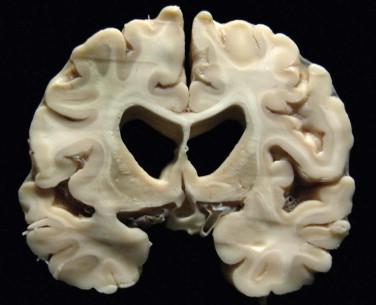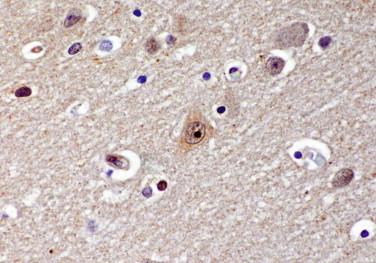Physical Address
304 North Cardinal St.
Dorchester Center, MA 02124
Autosomal dominant neurodegenerative disease characterized clinically by choreiform movements, psychiatric symptoms, and dementia and genetically by expansion of the trinucleotide (CAG) repeat in the HD gene
Age range: 2 to 85 years (mean age: 40)
Incidence: 2 to 4.7 per 1 million individuals/year
Prevalence: 5 to 8 per 100,000 individuals
No gender predominance
Autosomal dominant disorder caused by expanded CAG repeats in the HD gene on chromosome 4p resulting in abnormal encoding of Huntington protein
Interaction of mutated Huntington protein with other proteins results in neuron death
Huntington disease occurs with trinucleotide repeats >38 (normal 15 to 32)
Earlier age of onset and increased rate of disease progression associated with longer repeat sizes
Insidious onset of movement abnormalities (chorea), psychiatric manifestations (irritability, depression, anxiety), and cognitive abnormalities (memory loss, diminished decision-making ability, decreased concentration)
Successive generations have expanded trinucleotide repeat number with earlier and more severe phenotype (anticipation)
Fatal disease, duration of illness ranges from 2 to 45 years (mean age: 17)
Symptomatic treatment for involuntary movements and psychiatric symptoms
Imaging nonspecific; MRI may demonstrate striatal and cortical atrophy
Appearance based on stage of disease
Mild to marked cerebral atrophy with striking volume loss of the caudate nucleus and putamen, resulting in ex vacuo hydrocephalus
Degeneration of medium spiny neurons of neostriatum (caudate, putamen) with reactive gliosis in a dorsal to ventral pattern
Neuronal loss in cortical layers III, V, VI, hippocampus, amygdala, and entorhinal cortex
Vonsattel grading: determines pathologic severity in postmortem brains of patients with Huntington disease based on both neostriatum macroscopic atrophy and microscopic changes
Grade 0: no gross changes; 30% to 40% loss of striatal neurons without astrocytosis
Grade 1: no gross changes; 50% loss of striatal neurons with moderate astrocytosis in medial caudate and dorsal putamen
Grade 2: macroscopic atrophy of head of caudate nucleus and putamen with mild globus pallidus atrophy; evident neuronal loss in head/body/tail of caudate nucleus and dorsal putamen and associated astrocytosis
Grade 3: macroscopic severe atrophy of head of caudate nucleus and putamen with mild globus pallidus atrophy; evident neuronal loss in head/body/tail of caudate nucleus and dorsal putamen and associated astrocytosis; mild astrocytosis in globus pallidus
Grade 4: macroscopic very severe atrophy of head of caudate nucleus and putamen with severe globus pallidus atrophy; evident neuronal loss (>90%) in head/body/tail of caudate nucleus and dorsal putamen and associated severe astrocytosis; astrocytosis in nucleus accumbens
Immunohistochemical studies for ubiquitin may demonstrate dystrophic neurites and neuronal nuclear inclusions within the cerebral cortex and hippocampus (inclusions less commonly found in the striatum, amygdala, dentate nucleus, and red nucleus)
Intranuclear inclusions and dystrophic neurites may also be identified by immunohistochemistry for Huntingtin protein and expanded polyglutamine repeats
Other Huntington disease–like syndromes
Frontotemporal lobe degeneration
Pick disease
Multiple system atrophy
Corticobasal degeneration
Spinocerebellar ataxia (SCA) 17

![Fig 2, Huntington disease. Degeneration and loss of medium spiny neurons in the caudate and putamen is associated with marked reactive astrocytosis (glial fibrillary acidic protein [GFAP]-immunohistochemistry). Fig 2, Huntington disease. Degeneration and loss of medium spiny neurons in the caudate and putamen is associated with marked reactive astrocytosis (glial fibrillary acidic protein [GFAP]-immunohistochemistry).](https://storage.googleapis.com/dl.dentistrykey.com/clinical/TripleRepeatInheritedNeurodegenerations/1_3s20B9781416062202000440.jpg)

Friedreich's ataxia (FA) is one of at least six genetically distinct autosomal recessive spinocerebellar degenerations
Characterized clinically by progressive limb and gait ataxia, lower extremity weakness, and sensory loss and genetically by mutation of the FRDA (frataxin) gene on chromosome 9q
FA is the most common hereditary ataxia, accounting for about 50% of cases
Usually affects children and young adults, most frequently during puberty
Range 2 to 27 years (average age 15); 85% of patients present before age 20
Estimated incidence 2 per 100,000 individuals/year; prevalence 1 per 29,000 individuals
Predominant in whites, rare in black and Asian populations
Carrier frequency 2 to 3 in 180 individuals
No gender predominance
Become a Clinical Tree membership for Full access and enjoy Unlimited articles
If you are a member. Log in here